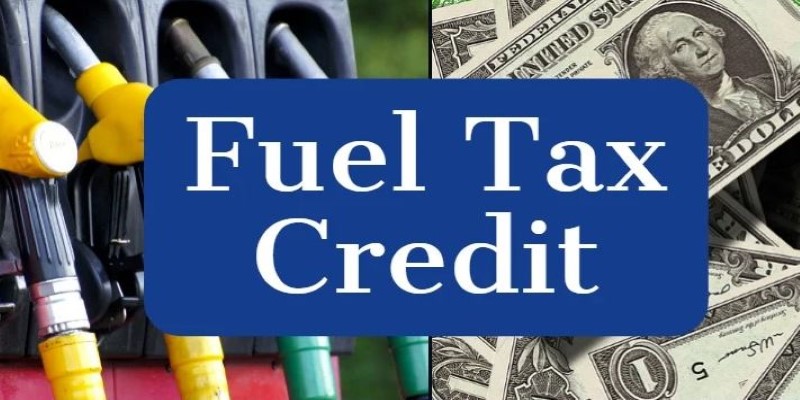The Power of the Alternative Fuels Tax Credit: Financial and Environmental Benefits
Dec 13, 2024 By Vicky Louisa
In recent years, there has been a growing emphasis on sustainable energy solutions, with financial incentives playing a key role in this shift. The Alternative Fuels Tax Credit is one such incentive designed to encourage individuals and businesses to adopt renewable energy sources by offering tax benefits. This credit helps reduce the carbon footprint of fuel consumption while also providing potential savings.

If youre curious about how the tax code supports alternative fuels and whether you qualify for this credit, youre not alone. In this article, well explore what credit is, how it works, and how to benefit from it.
What Is the Alternative Fuels Tax Credit?
The Alternative Fuels Tax Credit is a federal program that encourages the use of cleaner, renewable energies. Although the credit lessens reliance on more conventional fossil fuels like gasoline and diesel, it promotes more environmentally friendly alternatives. The credit applies to several such fuels, including ethanol, biodiesel, natural gas, and hydrogen.
By doing so, the credit helps to offset the expense of alternatively fueled use or production through financial incentives. It would result in lower operating costs for companies and keep money in consumers' pockets at the pumpall working towards cleaner energy consumption, reducing unfavorable environmental impacts, and fostering innovation within the energy sector to reach the U.S. climate and energy goals.
Types of Fuels Covered by the Alternative Fuels Tax Credit
The Alternative Fuels Tax Credit is one of the most widely covering fuels, all of which are considered to be environmentally friendly compared to the traditional use of gasoline and diesel. The types of fuels that qualify for credit are:
Ethanol and Biodiesel: Available credit may include ethanol, which is often produced from corn, as well as biodiesel, which is often produced from vegetable oils. Many vehicles can run using ethanol or biodiesel rather than gasoline or diesel, so increased use of these fuels may decrease carbon emissions related to traditional fuels.
Natural Gas: The tax credit also covers compressed natural gas (CNG) and liquefied natural gas (LNG). These fuels have been touted for their ability to reduce harmful emissions compared to conventional fuels, especially in heavy-duty vehicles.

Propane: Known for its cleaner emissions, propane is another fuel eligible for the Alternative Fuels Tax Credit. Its used in a variety of applications, from home heating to fueling vehicles.
Hydrogen: Hydrogen fuel cells are another option for alternative energy vehicles. Though less common than ethanol or natural gas, hydrogen vehicles are becoming more widespread, especially in commercial applications.
Other Renewable Fuels: The tax credit may also cover other renewable fuels produced from biomass, waste, or other sustainable sources. These fuels help reduce dependence on fossil fuels while encouraging the use of replenishable resources over time.
Each type of fuel has its specific set of rules, eligibility criteria, and benefits, so its important to understand which fuels apply to your situation.
How Does the Alternative Fuels Tax Credit Work?
To understand how the Alternative Fuels Tax Credit works, it's important to look at its specific application. Essentially, the tax credit reduces the amount of taxes owed by taxpayers who use alternative fuels or vehicles that run on renewable energy sources. However, the details can vary based on the type of fuel and the specific use case.
For example, if youre an individual using alternative fuels in your vehicle, the credit can apply to fuels like ethanol or compressed natural gas. If you own a business, the credit can apply to the installation of alternative fuel equipment, such as fueling stations or infrastructure that supports the use of renewable fuels.
One of the most common uses of the tax credit is for the consumption of alternative fuels in vehicles. If you fill up your car with ethanol or biodiesel, for example, you might be eligible for a certain dollar amount per gallon of fuel used. The exact amount of the credit can vary, and its subject to periodic adjustments by Congress.
Businesses that install fueling infrastructure or invest in alternative fuel vehicles can also benefit from the tax credit. The amount of credit they receive can depend on the equipment used, the type of fuel, and how much they spend on qualifying items. This flexibility is what makes the tax credit appealing to both individuals and businesses alike, as it can be used in many different contexts.
Benefits and Drawbacks of the Alternative Fuels Tax Credit
Like any tax incentive, the Alternative Fuels Tax Credit has both benefits and drawbacks, impacting financial and environmental decisions.
Benefits:
The Alternative Fuels Tax Credit encourages the use of cleaner, renewable energy by offering financial incentives. It reduces fuel costs for consumers using biofuels, natural gas, or hydrogen and supports businesses investing in eco-friendly infrastructure. This credit helps lower carbon emissions, contributing to environmental sustainability. Additionally, it stimulates innovation in the energy sector, promoting the development of new, cost-effective energy technologies that further reduce reliance on traditional fossil fuels.
Drawbacks:

While the Alternative Fuels Tax Credit offers financial benefits, its eligibility criteria can be complex, making it challenging for some individuals and businesses to fully understand or claim it. The credit amount can also vary, and it may not fully offset the higher upfront costs of alternative fuel vehicles or infrastructure. Additionally, changes to tax laws or expiration of the credit can create uncertainty, potentially limiting its long-term effectiveness as a reliable incentive.
Conclusion
The Alternative Fuels Tax Credit is a valuable tool for individuals and businesses looking to reduce their environmental impact and save money. It encourages the use of renewable energy sources like ethanol and natural gas, helping create a more sustainable future. By understanding how credit works, you can take advantage of the savings it offers while supporting a cleaner, greener planet. This credit not only lowers your tax liability but also contributes to broader environmental goals.








